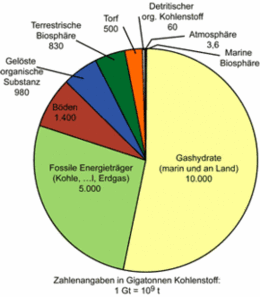Page path:
- General/Marine Geology
- Gas Hydrate Research
- Potential Source of Energy
Potential Source of Energy
In comparison with other important global deposits, gas hydrates store an extremely large quantity of organic carbon. There are some uncertainties with regard to the global budget, yet it is believed that gas hydrates incorporate approximately 10,000 gigatons of carbon. This exceeds by far the amount of carbon stored in fossil fuels. Gas hydrates could therefore be a potential source of energy in the future when conventional fossil fuels run out. A potential exploration of hydrates, however, raises two major issues. First: a production and use of gas hydrates will also release the greenhouse gas carbon dioxide (see effect on global climate). Second: A production technology that is cost-effective and at the same time environmentally sound has yet to be developed, for marine gas hydrates as well as for permafrost hydrates.

Picture:
The Earth's carbon reserves, broken down into different reservoir types. Finely distributed organic carbon which in sum may contribute a much larger portion, have not been considered (Kvenvolden 1988).
The Earth's carbon reserves, broken down into different reservoir types. Finely distributed organic carbon which in sum may contribute a much larger portion, have not been considered (Kvenvolden 1988).
The resources of fossil fuels available to the gas industry are still sufficient for more than one generation. Only a few countries - such as Japan, which do not have any mentionable natural deposits of oil and gas - are implementing serious studies concerning an economic gas production from hydrates. A production from marine gas hydrates appears most attractive because of the large quantities available, but it is in fact less likely to be achieved in a short-term perspective for several reasons: The conditions for production are far more complicated than in permafrost regions and the geohazards involved as well as the impact on the environment are difficult to assess. In Siberia, there already exists a small-scale gas production from permafrost gas hydrates. In the near future, this kind of gas production could become more important.


